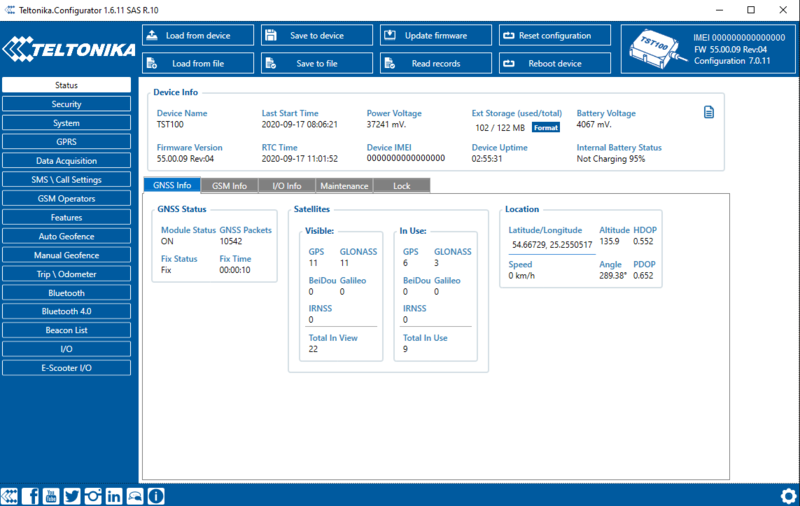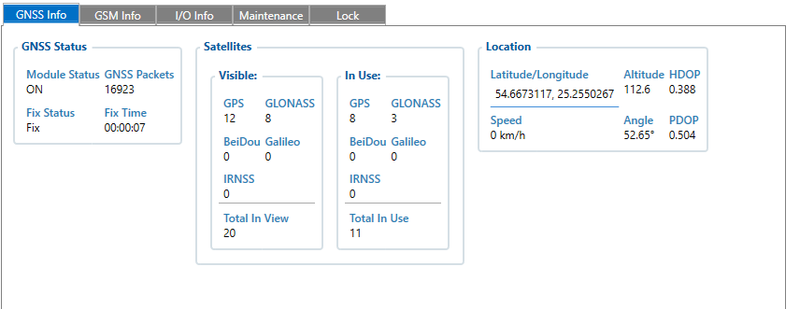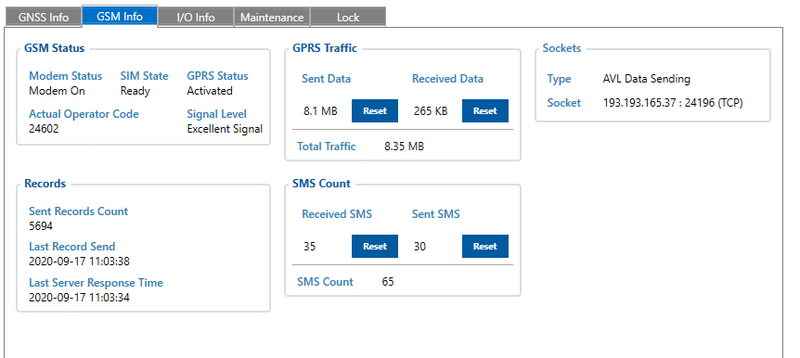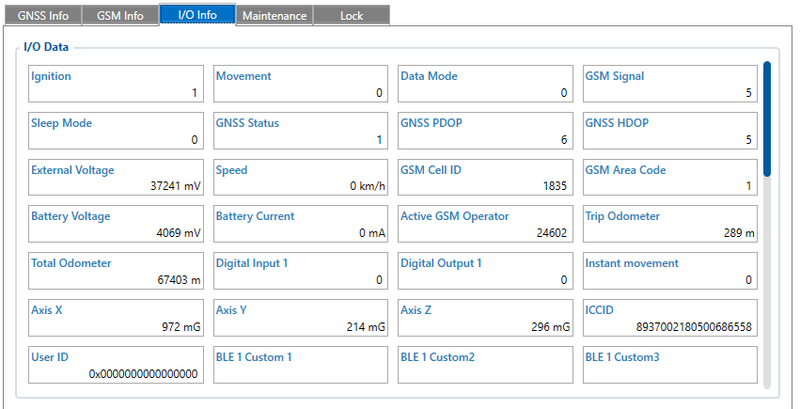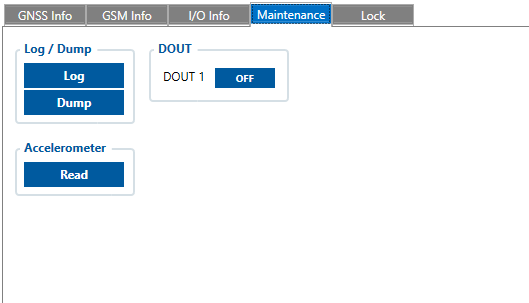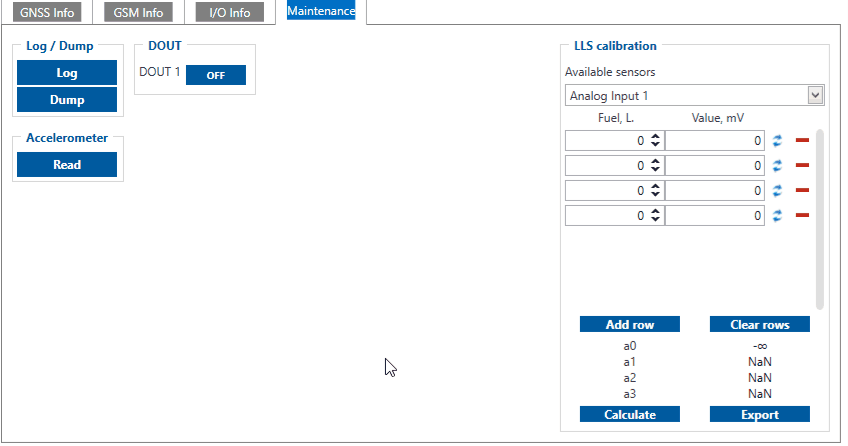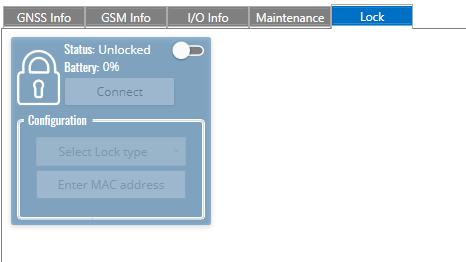TST100 Status info
Status info enables the user to monitor real time information of TST100. Following fields are displayed: Device Info, GNSS Info, GSM Info, I/O Info, Maintenance and etc. User is able to export all of the information to .HTML file using ![]() icon which is at the top right corner of the Device Info area.
icon which is at the top right corner of the Device Info area.
Device Info
- Device Name
- Firmware version
- Last Start Time - last device start time.
- RTC Time - real-time clock or current device time.
- Power Voltage (mV)
- Device IMEI
- External Storage (used/total) - Internal Flash memory free space.
- Device Uptime - device uptime from last start time.
- Battery Voltage (mV)
- Internal Battery Status - Charging/Not Charging
GNSS Info
- GNSS status
- Module status - ON, GPS Sleep, Deep Sleep, Online Deep Sleep, Ultra Deep Sleep mode.
- GNSS packets - the number of GNSS packets the device received from startup.
- Fix Status - Fix/No Fix. (Note: Fix time strongly depends on indoor/outdoor location. To achieve best performance acquiring GNSS fix device should be used in outdoor locations)
- Fix Time - the last GNSS fix time.
- Satellites
- Visible - the number and type of satellites that are visible.
- In Use - the number of satellites used for location positioning.
- Location
- Latitude/Longitude - shows current device coordinates and if you press them opens Object location window with a map.
- Altitude, Angle
- HDOP, PDOP
TST100 sends HDOP/PDOP value to the server in precision of dilution coefficient. HDOP/PDOP calculation depends on how many GNSS sources are selected. If configured GNSS Source options are "GPS" and "GLONASS" and HDOP/PDOP values are received from both systems, the parameters HDOP/PDOP will be calculated as shown below:
"GPS" - 1.60;
"GLONASS" - 1.60;
"Galileo" - will be 0, because it is not selected and not taken into account;
"BeiDou" - will be 0, because it is not selected and not taken into account;
Calculation formula - ("GPS" + "GLONASS" + "Galileo" + "BeiDou") / 4 (four GNSS systems).
Calculated HDOP/PDOP value according to above parameters - (1.60 + 1.60 + 0 + 0) / 4 = 0.8 coefficient. - Speed - current device speed.
HDOP/PDOP value calculation changes
Main calculations of separate HDOP/PDOP values of GPS, GLONASS, Galileo and BeiDou are made by GNSS modem. GNSS Modem already outputs average of HDOP/PDOP from 4 GNSS systems (Used satellites) with a formula below.
Calculation formula - ("GPS" + "GLONASS" + "Galileo (0-sat)" + "BeiDou (0-sat)") / 2 (four GNSS systems)**
Calculation formula - ("GPS" + "GLONASS") / 2 (two GNSS systems)
HDOP/PDOP will be different if it will have 19 and i.e. other packet with 6 satellites. In parsed regular AVL packet example below all of 19 satellites are shown as in use.
Parsed NMEA Record Example:
Record GPS longitude : -14116383
Record GPS latitude : 530738950
Record GPS altitude : 356
Record GPS angle : 357
Record GPS satellites: 19
Record GPS Kmh : 102
GSM Info
- GSM status
- Modem Status
- SIM State - Ready/Unknown
- GPRS Status - Activated/Deactivated
- Actual Operator Code
- Signal Level
- GPRS traffic
- Sent Data - the amount of data that has been sent by the device.
- Received Data - the amount of data that has been received by the device.
- Total Traffic - Sent Data + Received Data
- Sockets information:
- Type - AVL Data Sending
- Socket - Closed or Server domain and port which is used when sending AVL Data via TCP/UDP.
- Records
- Sent Records count - how many records were sent to the server since the last data reset.
- Last Record Send - date and time when the last record was sent.
- Last Server Response Time - date and time when the last server response was.
- SMS Count
- Received SMS - the amount of SMS messages the device has received.
- Sent SMS - the amount of SMS responses that were sent from the device.
- SMS Count - Received SMS + Sent SMS
I/O Info
- I/O Data - shows the current values from all configurable I/O elements.
Maintenance
- Log/Dump
- Log - after button is pressed, the device starts log capturing for 10 minutes with configuration download. After this time device .log and configuration .cfg will be in compressed archive.
Archive name:
YYYY_MM_DD_HH_MM_SS_TST100_IMEI_Log.zip
Default directory:C:\Users\<username>\Documents
- Log - after button is pressed, the device starts log capturing for 10 minutes with configuration download. After this time device .log and configuration .cfg will be in compressed archive.
- Dump - after button is pressed, the device starts to download .dmp logs and configuration .cfg from device in compressed archive.
Archive name:
YYYY_MM_DD_HH_MM_SS_TST100_IMEI_Dump.zip
Default directory:C:\Users\<username>\Documents
Dump files can be read only with special software. If needed, provide these files to your Teltonika sales manager or Teltonika Support team. - Open directory - this button appears near Log or Dump if one of these functions were used.
- Dump - after button is pressed, the device starts to download .dmp logs and configuration .cfg from device in compressed archive.
- Accelerometer - after the button is pressed, the device starts to capture accelerometer values for 1 second.
Lock
- Allows user to connect TST100 to Solebe Y905 Bluetooth lock. After connecting, user is able to:
- Disable functionality;
- Update lock status;
- Unlock the Bluetooth lock;
- Change lock password.
Information about how to use Solebe Y905 Bluetooth lock with TST100 can be found here.
